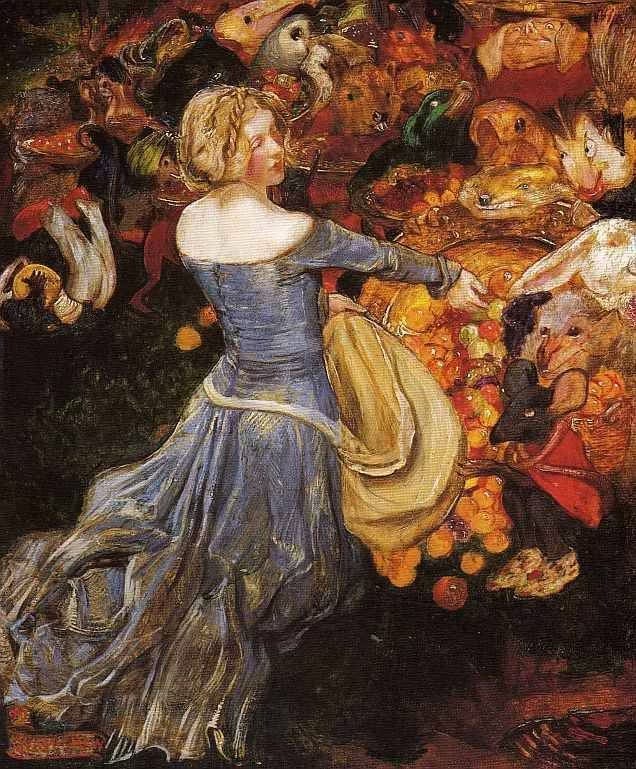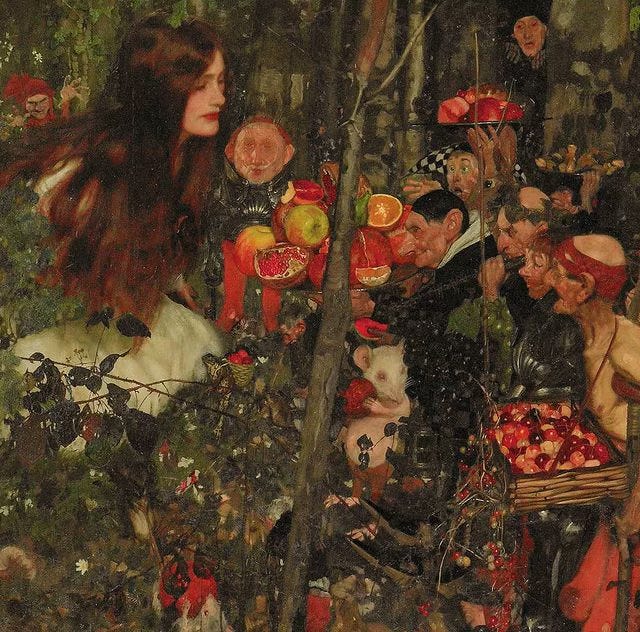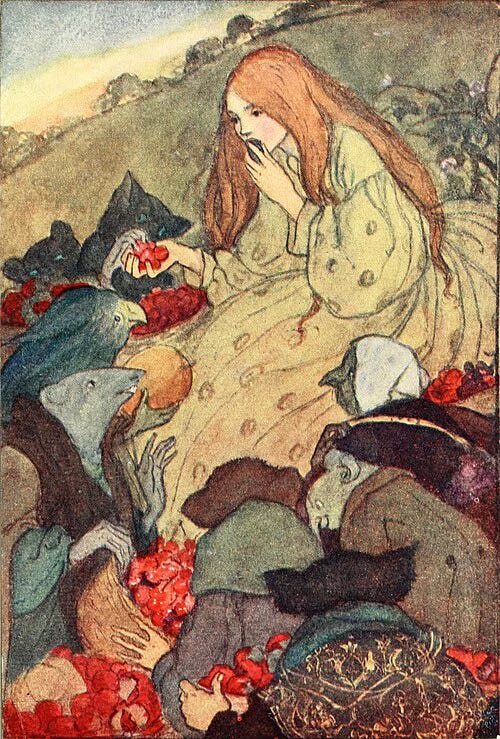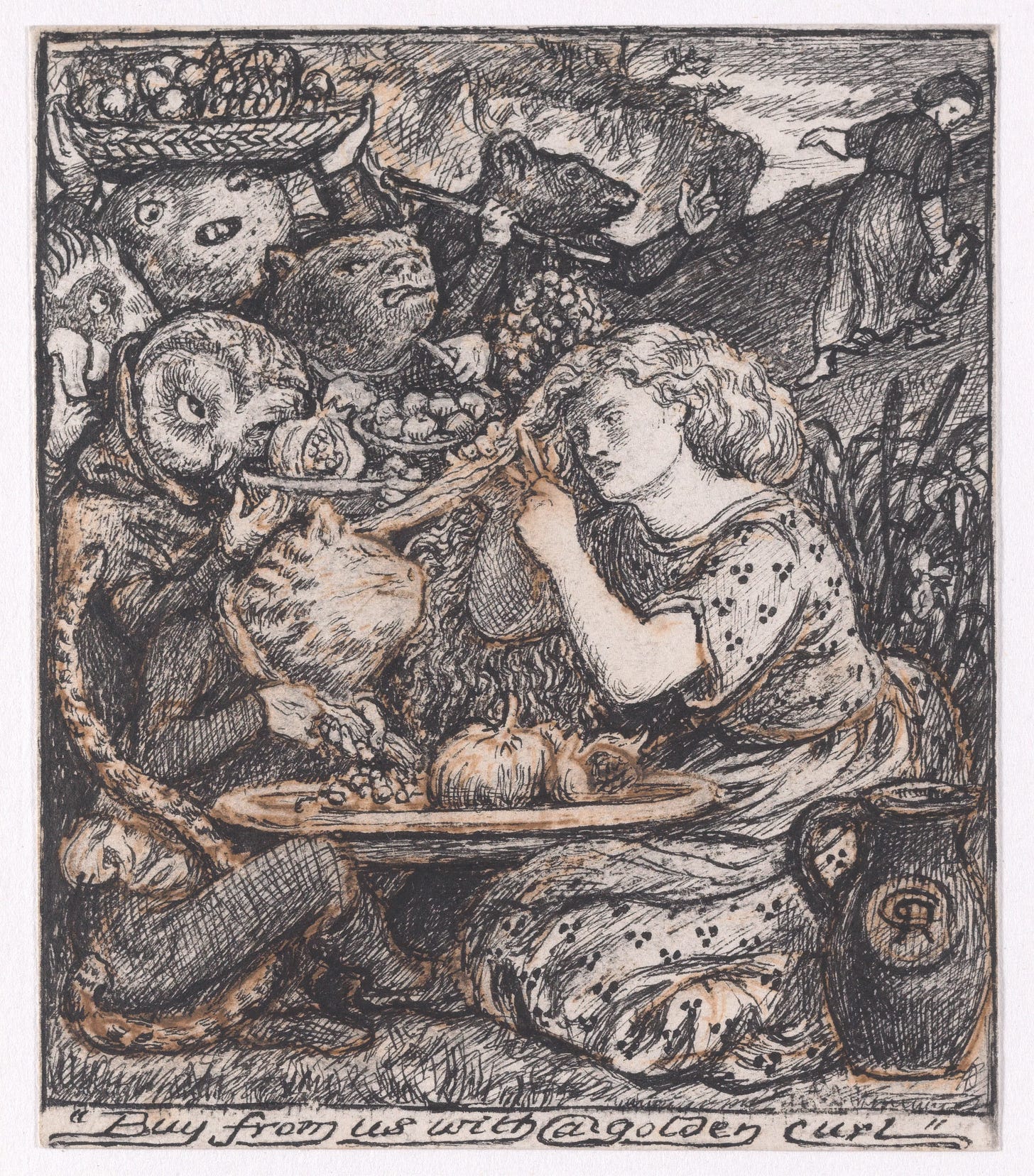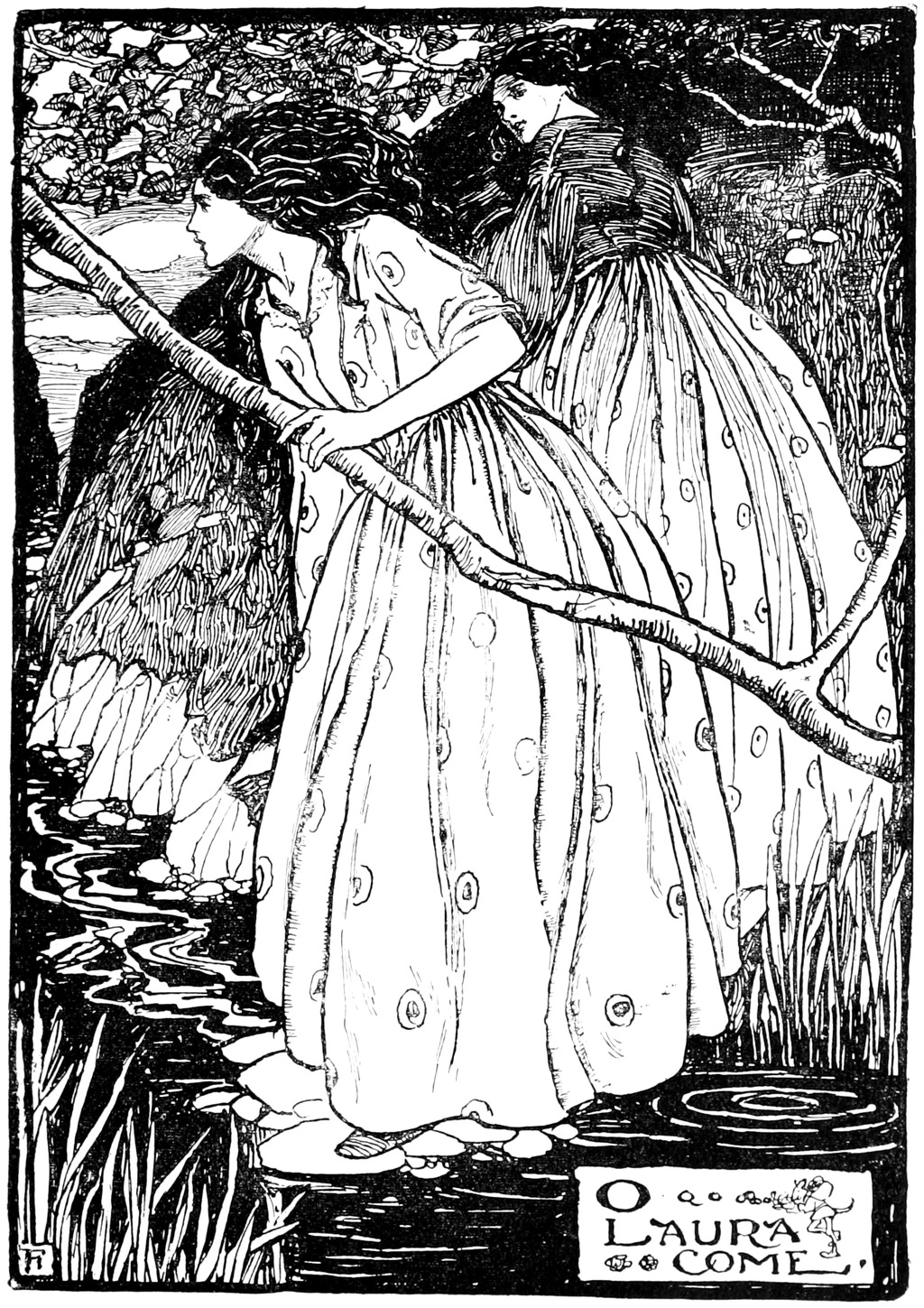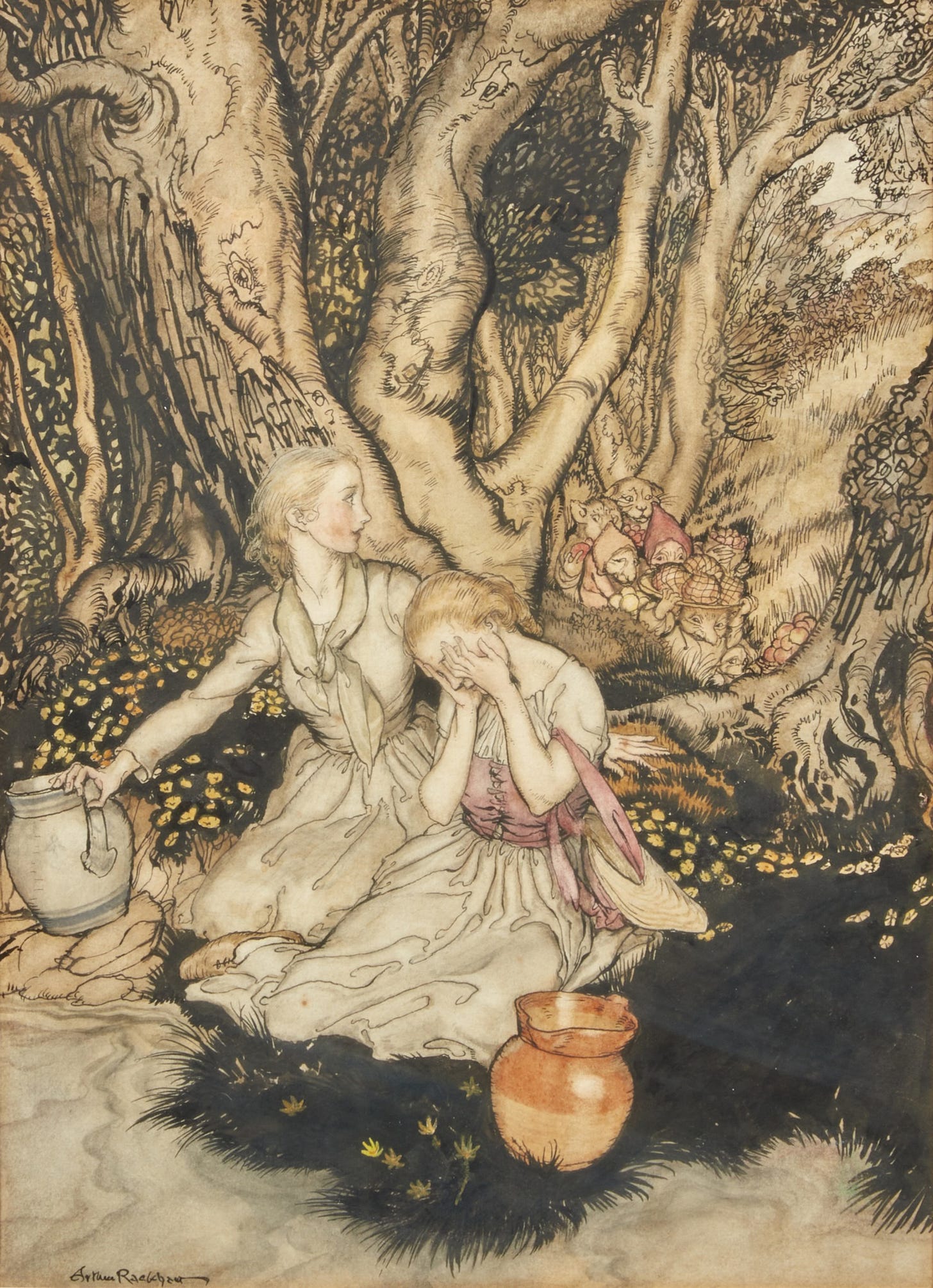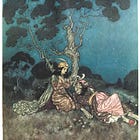Click above to read the poem “Goblin Market” by British writer Christina Rossetti (1830–1894).
Most of the scholars who have studied and interpreted “Goblin Market” have found meaning in the way it explores issues of sexual purity or addiction and the way that it portrays markets and trade. It is a complex fairy story that could be read and interpreted in myriad ways, not all of them relevant to our current discussion. But the first image that stands out in our context of Atonement metaphors in fairy stories is the very dangerous and very seductive fruit the Goblins give Laura.
Each of the stories we have read so far contains a fruit, and in the way we are reading these stories, each of these fruits is a vehicle for sin. However, the shapes of the stories change the meaning of sin, what it is, and who we are.
In “Snow White,” sin is death.
Snow White’s apple is crafted by the evil queen to trick Snow White into eating it: “The outside looked very rosy and tempting, but whoever tasted it was sure to die.” The queen even goes so far as to make only one side of the apple poisonous so that she can take a harmless bite to demonstrate the safety of the apple to Snow. This matches one telling of the story of Eve, where she is tricked into eating the fruit by the devil, she sins when she does this, and, because of her actions, all people are cursed to die physically and spiritually.
In Beauty and the Beast, sin is criminality.
The rose is not the literal fruit of the tree of knowledge of good and evil, plucked by one person and leading to the condemnation of all. Instead, the fruit is the sins that mortals commit. The merchant breaks the Beast’s law when he picks a single, beautiful rose from the garden, and justice requires payment.
How is Goblin Market different? In Goblin Market, two sisters, Lizzie and Laura, are tempted by the Goblin men to buy their fruits. We hear the repeated refrain, “Come buy, Come buy:”
Taste them and try: Currants and gooseberries, Bright-fire-like barberries, Figs to fill your mouth, Citrons from the South, Sweet to tongue and sound to eye; Come buy, come buy. (lines 25–31)
Lizzie resists, but Laura does not. With a lock of her hair, she buys the Goblin fruit. It turns out that you can get a lot of fruit for one lock of hair:
She suck’d and suck’d and suck’d the more Fruits which that unknown orchard bore; She suck’d until her lips were sore” (lines 134–136).
It is not against the law to eat Goblin fruit, so no beast or angel or sheriff shows up to arrest Laura for eating it. And it does not bring instant death—although eating it can lead to eventual death. So what happens when Laura eats it?
She gets sick.
In “Goblin Market,” sin is not death, and sin is not criminality. Sin is woundedness.
Woundedness
All three of these metaphors use fruit to represent sin, but as discussed in the previous essay, conceptual metaphors “provide us with a partial understanding of what [sin and Atonement] are and . . . in doing this, they hide other aspects of these concepts” (Lakoff and Johnson 12). The differences between death, criminality, and woundedness are immense.
In All Things New, Fiona and Terryl Givens present a thorough analysis of what we can gain from looking at sin as woundedness. They argue that the metaphor of woundedness emphasizes “the larger context in which sin operates—which context is the purpose for our mortal journey” (101). They write:
Woundedness is essential and inevitable in the Great Plan’s unfolding. It is through our necessary experience of the bitter that we may learn to prize the sweetness of what is good and pure and beautiful—the sweetness that is Christ. . . . We learn that certain choices we make . . . take us to a place that is “contrary to the nature of happiness (Alma 41:11).” (106)
Laura’s decision to eat the goblin fruit takes her to this place that is contrary to the nature of happiness. Lips sore, not knowing night from day, she goes home and almost immediately begins to pine. Her desire for more of the goblin fruit makes her ill.
The first mention of her sickness doesn’t sound too serious. Lizzie, it says, is “content,” while Laura is “sick in part” (line 212). But as the poem continues, the descriptions of Laura’s bad health become more frequent and more vivid until it is clear that she is very sick indeed:
Her tree of life dropped from the root (line 260) Her hair grew thin and gray (line 277) She had “sunk eyes and faded mouth” (line 288) Sat “listless . . . and would not eat.” (lines 297–298) Till Laura dwindling/Seemed knocking at Death’s door (lines 320–321)
Eventually, Laura is near the point of death, and she knows from the example of her friend Jeanie, who “fell sick and died/in her gay prime” (lines 315–316) that this sickness has only one end. She is going to die.
Or at least, she would if she were left on her own. She would continue to dwindle, always craving more and more goblin fruit, until she wasted away. The fruit has twisted her, broken her, and wounded a part of her that she cannot heal. Hers is a death of longing, an addiction that she cannot overcome on her own. But she is not the only character in this fairy story. And if she is a vehicle for each of us—lost in our sins, looking for wholeness—her sister Lizzie is a vehicle for Christ.
Then Lizzie weigh'd no more Better and worse; But put a silver penny in her purse, Kiss'd Laura, cross'd the heath with clumps of furze At twilight, halted by the brook: And for the first time in her life Began to listen and look. (lines 322–328)
Lizzie condescends to go back to the Goblin Market to save her sister. She listens to what the market has to offer. She looks at what is going on there, sharing Laura’s experiences, but only to a point, only to save her.
Why Is the Healing so Radical?
When sin is woundedness, Atonement is radical healing, and the “radical” is very important.
Healing is an everyday, mundane part of our lives—think scraped knees, sunburns, and white blood cells fighting off the latest mutation of the latest virus. But radical healing is a grand, supernatural miracle—think Christ healing the blind man (John 9), the woman with an issue of blood (Luke 8:43–48), or the ten lepers (Luke 17:11–19).
If we used the metaphor of everyday healing to explain the Atonement, it would be very similar to the metaphor of restoration. After all, when an injury or sickness is healed, the injured party has been restored to health. But “radical healing” is about more than mere restoration in the same way that Christ healing the paralyzed man at the pool of Bethesda (John 5) is a greater miracle than the recovery I made after the cold I had last fall.
Alma preached that Christ would “go forth, suffering pains and afflictions and temptations of every kind; and this that the word might be fulfilled which saith he will take upon him the pains and the sicknesses of his people” (Alma 7:11). Similarly, Isaiah writes that “with his stripes we are healed” (Isaiah 53:5).
Jesus Christ is a healer. During his mortal ministry, he continually healed the sick and the wounded, and he didn’t discriminate between healing physical and spiritual wounds. The story of the man who was sick of the palsy offers a great example of how Christ looked after both spiritual and physical needs:
He said unto the sick of the palsy, “Son, thy sins be forgiven thee.”
But there were certain of the scribes sitting there, and reasoning in their hearts,
“Why doth this man thus speak blasphemies? Who can forgive sins but God only?” . . .
[And he said unto them] “Whether is it easier to say to the sick of the palsy, Thy sins be forgiven thee; or to say, Arise, and take up thy bed, and walk?
But that ye may know that the Son of man hath power on earth to forgive sins, (he saith to the sick of the palsy)
I say unto thee, Arise, and take up thy bed, and go thy way into thine house.” (Mark 2:5–11)
This story shows Christ ministering to a whole person. The man is forgiven—healed from sin—and he is healed physically, to witness that the spiritual healing is true. Fiona and Terryl Givens write, “Sinning is a type of woundedness, like blindness or lameness. It is an infirmity, a brokenness. As a Healer, He ministers to the entire range of our afflictions: psychological, emotional, physical, and spiritual” (All Things New, 140).
Lizzie’s Miracle
As a Christ figure, Lizzie has a lot to teach us about ministering. When she returns to the goblin market, she returns full of love, wanting nothing more than to save her sister Laura.
She has been with Laura from the beginning. She warns her sister of the dangers of the fruit, and then after Laura eats it, she is the first to hear Laura’s story and plans to return and buy more fruit later. Lizzie does not reject Laura for her decision but stays with her:
Golden head by golden head, Like two pigeons in one nest Folded in each other’s wings, They lay down in their curtain’d bed: . . . Cheek to cheek and breast to breast Lock’d together in one nest. (lines 185–191)
Lizzie’s love never wavers, but in addition to perfect love, Lizzie brings another gift: she never tastes of the goblin fruit. Her miracle is then made through the combination of her love and her perfection.
Lizzie returns to the market, which feels like a vehicle for Christ’s condescension to the world. She meets the temptations of the goblin fruit. She tosses her penny at the men, asking for fruits to carry home to her sister, but they will not.
“Nay, take a seat with us,” they say,
“Honour and eat with us,” They answer'd grinning: "Our feast is but beginning.” (lines 368–371).
But Lizzie doesn’t eat with them.
“Sit down and feast with us, Be welcome guest with us, Cheer you and rest with us.” (lines 380–382).
But Lizzie doesn’t sit with them. She thinks only of Laura.
When the goblins see that she will not be tempted, they try a different approach, becoming violent and aggressive. But still, they cannot force her. She doesn’t eat a single bite. First, she is not tempted, and then, when the goblins become violent, she is still unmoved, thinking only of her sister.
Lizzie utter’d not a word; Would not open lip from lip Lest they should cram a mouthful in: (lines 430–432)
And it works! When the Goblins tire of tormenting her, when they give up on trying to force the fruit into Lizzie’s mouth, she returns to Laura, her face and neck dripping with the juice that her sister has been longing for.
Eat me, drink me, love me; Laura, make much of me; For your sake I have braved the glen And had to do with goblin merchant men. (lines 471–474)
Here, Lizzie is not only a savior for Laura, she becomes, in essence, the Eucharist. “Eat me, drink me, love me;” she cries to her sister. For Laura’s sake, she went to the market in search of a moment of relief for her sister. But the sticky fruit Lizzie carries gives Laura more than a moment of relief from her longing, it radically heals her. When Laura kisses her sister, tasting that forbidden fruit on her sister’s lips, “she loathe[s] the feast” (line 495). She doesn’t desire the fruit anymore. Fire fills her veins as it burns out her wounds and sickness. “Life out of Death,” the poem says as Laura is made whole (line 524).
Lizzie is Laura’s savior. But she doesn’t justify her; she heals her. Her tender care of Laura during convalescence offers us a wonderful metaphor for a Christ who is gentle, caring, and present for our healing.
That night long Lizzie watch’d by her, Counted her pulse’s flagging stir, Felt for her breath, Held water to her lips, and cool’d her face With tears and fanning leaves: (lines 525–529)
This is a beautiful Eucatastrophe. Laura avoids certain death and is wiser and stronger after the experience. The sisters go on to live long lives together, even becoming mothers who tell the story of their miracle to their children.
In On Fairy Stories, as Tolkien describes what fairy stories are good for, he uses the word recovery, defining it first as “a return and renewal of health” and second as “a re-gaining of a clear view” (66–67). This idea—that we are better able to see the world and ourselves through the lens of fantasy—is also shared by writer and folklorist Jane Yolen, who explains that the best stories “are the most potent kind of magic, these tales, for they catch a glimpse of the soul beneath the skin” (57). Fairy tales give us newer, clearer visions of ourselves as they throw us into situations and relationships that force us to confront our inner souls. This confrontation with the self can be a powerful teacher, helping us find healing and preparing us to go out into the real world with optimism, looking for meaning and purpose.
That is what this story does to me. When my soul is sick, when I feel like life has battered and bruised me, I can read about Lizzie and understand my Savior a little bit more. I can peek into the dark forest and see him there, a stalwart and unmoving oak filled with birds and squirrels. For “he doeth not anything save it be for the benefit of the world” (2 Nephi: 24).
And just as Laura’s miracle was enabled by Lizzie’s resistance to temptation, the same resistance enables Christ’s greatest miracle: his Atonement. He saw and felt—he experienced—all that I have. He “suffered temptations, but gave no heed unto them” (D&C 20:22). I don’t know why and how his perfections give him the ability to perform this miracle, just like I don’t know why and how Lizzie’s second visit to the Goblin Market saves Laura, but it does.
Like Laura, we are wounded emotionally, spiritually, and physically. Our wounds are deep: grief, trauma, addiction, violence, hurt, depression, war, abuse, extortion, anxiety, pain. At times, our woundedness seems hopeless to cure. But we have a Savior with the requisite love, mercy, and capacity to overcome it anyway. He loves us; he understands us; he understands our mortal experiences. He has seen it all and felt it all, and then, even after all of that, has never given in to sin. He is our happy ending.
Chanel Earl is a writer—mostly of fiction—who currently teaches writing at Brigham Young University.
Art by John Byam Shaw (1872-1919), Frank Craig (1902-1951), Florence Harrison (1877-1955), Dante Gabriel Rossetti (1828-1882), Hilda Koe (1872-1936), Arthur Rackham (1867-1939).



